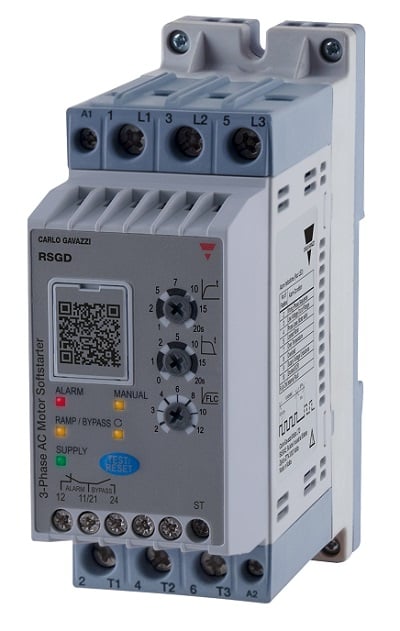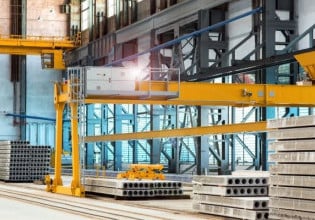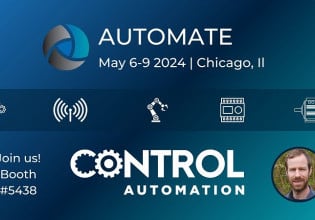What is a Soft Start? Reducing Start-up Load on Motor Circuits
Controlling the startup of a motor not only reduces the wear on the motor, but eases the burden on the electrical supply, reducing infrastructure demands and the running cost of industrial loads.
The expression “hit the ground running” sounds great in theory, it is meant to sound like getting a headstart. However, reality never works that way. If you really were dropped onto the ground, legs kicking to “hit the ground running” you would likely fall flat on your face as the actual friction of propelling your body comes into play and suddenly, your muscles encounter a massive feedback force.
As it turns out, machines are no different. Turning on a motor and expecting it to run at full speed, right away (even if it were mechanically possible), would lead to all sorts of problems. While the motor may not literally fall down, it would require tremendous startup currents, create ridiculous stresses on components (including the motor itself), and other such issues.
What Are Soft Starts?
Instead of running immediately at full power, electrical motors and other industrial loads rely on a “soft start” system, where full power is not applied to the motor until the motor is ready for it. Numerous mechanisms are used for soft starting (not just the actual soft starter devices), but the idea is the same: the motor must transition from rest to its steady state operating speed. Motors will be the direct focus of this article, but through extension, keep in mind that motors drive pumps, blowers, compressors, generators, and other industrial equipment.
Another reason for a soft start is to reduce the load on the power supply. Ever notice the lights dim when your refrigerator compressor, air conditioner, or large heater starts running? The same thing happens when starting any motor. The large inrush current required to start the motor can cause the power supply voltage to drop. In an industrial setting, this can reset controllers, reboot computers, cause communication drops, and generally wreak havoc on an otherwise stable factory.
Similarly, plumbing hardware does not respond favorably to rapidly opening or closing of valves or turning on pumps. A condition known as water hammer can violently slam plumbing, even causing catastrophic failure. Therefore, it is wise to soft start pumps for this reason, let alone the electrical motor driving the pump.

Figure 1. This metal float was destroyed by water hammer, the pressure spike from a valve closing or a pump starting too quickly. Image used courtesy of Wikipedia
Soft Starting Mechanisms
Soft start mechanisms can be divided into two classifications: electrical and mechanical. While both classifications have components that are in both categories, the major distinction is what actually selects the speed. For example, an electric motor may rely on a mechanical centrifugal switch to select the speed. In this case, the mechanism is mechanical.
Electrical
There are quite a few ways to electronically soft start a motor, some of which are more complicated than others.
Star-Delta Starters
On the less complicated end are autotransformers with multiple taps. As the motor speed increases, different sets of transformer taps are selected to speed up the motor. In a similar vein, motor starters can be configured with a lower oil voltage to start, then raised to a higher voltage as the motor approaches the rated speed (these are called star-delta motor starters, or wye-start, delta-run).
VFDs
On the more complicated end, variable frequency drives (VFDs) can be used to apply preconfigured linear and curved ramp profiles, gradually increasing the speed of the motor through sensor feedback and process control loops.
Soft Starters
There are also plenty of solutions in between transformers and VFDs. While VFDs are growing in popularity as the cost of their manufacturing decreases, sometimes a simpler solution is all that is required. There is one device that is officially named the ‘soft starter’ to accomplish this purpose with significantly simpler functionality than a VFD.

Figure 2. DIN-rail mounted soft starter. Image used courtesy of Carlo Gavazzi
One way to create a soft start is to perform wave chopping of an alternating current (AC) signal. By using thyristors (or silicon controlled rectifiers, SCRs), slices of the AC waveform are transmitted to the motor, and the rest is attenuated. By adjusting the ‘firing’ angle, or basically the phase shift of the SCRs, one can adjust the voltage sent to the motor.
The firing angle is controlled through a timing and triggering circuit. Diodes, including the SCR, only conduct current in one direction once a particular ‘breakover’ voltage is overcome. The triggering circuit evaluates the AC signal and develops a control signal that will allow the diode to conduct in the forward direction. The control signal determines how much of the AC waveform is transmitted.
Mechanical
Mechanical soft-start mechanisms are divided into two major categories: torque limiters and fluid friction mechanisms. In either case, full power is not applied to the motor immediately. Some torque limiters are based on centrifugal forces that can engage or disengage different sets of windings on electric motors.
Torque Converters
In some ways, an automatic transmission’s torque converter can be thought of as a soft-start, slowly (in a relative sense) applying engine torque to the transmission through a viscous fluid. It provides a little bit of slip, but then hydraulic coupling between the engine and transmission at the appropriate times.
Bypassing the Soft Start Mechanism
Soft start mechanisms should be automatically bypassed or shut off once the device has approached steady state. This saves wear and tear on the soft-start mechanism and allows the device to perform more efficiently, since no electricity will be wasted in the start-up device. As an example, soft start mechanisms that provide either electrical or mechanical resistance during startup, are converting energy into heat. If this mechanism can be bypassed during normal operation, the whole system is more efficient.
The soft-start part of the routine is completed when the device reaches steady state. Steady state can be defined as a motor reaching its final or target speed, as detected by a hall effect sensor or encoder for closed-loop control. For motors or other devices, a target current can be measured. This will typically need to trigger after the startup inrush current has been reached, and the current begins to drop as the motor approaches steady state.

Figure 3. Large compressors, pumps, and fans are some of the high-inertia devices that are well-served by softer start up cycles. Image used courtesy of Adobe Stock
Bypassing the soft start mechanism can be performed by switching to a separate set of contacts or autotransformer taps. There are also some solid-state and microcontroller solutions as well.
Safer for Equipment, Safer for People
Soft starts provide a safe and efficient way to apply power to a motor. While the soft start reduces unnecessary wear on components, it is also a safety mechanism, protecting the people working near machines. A soft start on an assembly line means components are not jerked rapidly, and are less likely to fall over. It also gives the employees a moment to recognize that the line is about to start moving. In fluid applications, a pump that has been soft started is less likely to water hammer. Water hammer has been known to violently rupture pipes and cause valves and fittings to explode. Soft starts extend the lifetimes of both equipment and people.







Nice write-up, Informative
Close but no cigar. Motors are perfectly happy with the inrush current but the load may not like the acceleration. Water hammer truly only occurs when the pump is stopped but can be mitigated with the proper soft start. Most electrical soft starts employ a bypass contactor to allow smaller rated SCRs and reduce cost. That’s enough for now.